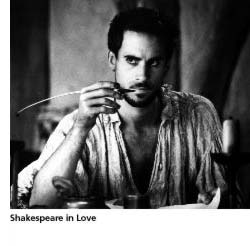
Shakespeare...
Posted on 06/23/2006 11:27:47 AM PDT by nickcarraway
Scores of literature students and buffs think that, after 400 years, they know Shakespeare - the balding guy with frilly neckware, a goatee and a stiff upper lip who brought us the mercurial musings of Hamlet and the amorous entreaties of Romeo.
Not everyone sees him that way.
British painter John Taylor saw William Shakespeare as a bit more bohemian, an Elizabethan hipster. His portrait has the bard in a long beard, plain white collar, disheveled hair and a gold hoop in his left ear.
The truth is nobody knows what Shakespeare looked like because there is no record that he ever sat for a portrait. But that doesn't mean people haven't tried to figure it out.
A new exhibit at the Yale Center for British Art opening today attempts to determine not only the true likeness of Shakespeare but also how the playwright and poet was understood by his fellow actors and writers.
"Searching for Shakespeare," a show that originated at the National Portrait Gallery in London, pulls together the best-known portrait, called the Chandos, and five other contenders that portray Shakespeare at different stages of life - as a young man, a 16th-century beatnik and, finally, as the aristocratic artist most people recognize."In all likeliness, Shakespeare had his portrait painted, as many others in his circle. Does that portrait exist? We can't be hand-on-heart absolutely sure, but (the Chandos portrait) has the strongest claim to being an authentic lifetime portrait of the playwright," said British art historian, Tarnya Cooper. That portrait was hung in Britain's National Portrait Gallery in London in 1856.
The display also includes supplemental material - including books and original documents from his lifetime and his signed will - to partially reconstruct the man behind the famous plays and sonnets. "We'll never entirely know Shakespeare, or what he looks like, but I believe what we have found in the Chandos portrait is the face of a beautiful man who could write," Cooper said. While the Chandos portrait, named after a previous owner, probably shows the true Shakespeare, scholars cannot discount two other key artifacts in "Searching for Shakespeare" - an engraving of Shakespeare that appeared in the first posthumously printed edition of his plays, and a memorial bust taken from his monument at a church in his hometown Stratford-upon-Avon. His family probably commissioned both pieces from portrait miniatures or another portrait, and through both, intentionally put forth a stately image of Shakespeare, which has been the most widely circulated.
The appearance of the Chandos portrait in 1856 and the gradual emergence of the five others in the exhibit threw curators and art historians for a loop.
"These portraits have widely differing virtues. For some we have a date and no certainty of the subject, for others we have a construction of the subject but a date that does not match the period of his life," wrote Sandy Nairne, National Gallery director, in the exhibit catalog.
"The history of each painting plays a fascinating and vital part of the Holy Grail question of whether a painted portrait can ever be authenticated."
Throughout the 20th century, a competitor, the Grafton portrait, the first of the five, had numerous champions expressing the hope that it showed the real Shakespeare. Depicting a beautiful young man with the beginnings of a receding hairline wearing a scarlet jacket, the Grafton portrait features an inscription that records the sitter's age at 24 in 1588, making him an exact contemporary of Shakespeare. Found in the late 19th century in a tavern north of Yorkshire, conservators have not completely discredited the Grafton portrait, but largely believe the romantic notion of seeing Shakespeare in his youth drives the debate.
Another, the Sanders portrait, dating to 1603 reveals circumstantial evidence of Shakespearean authenticity. A damaged label on the back of the painting reads: "Shakpere/Born April 23 = 1564 / Died April 23 -1616 / Aged 52 / This likeness taken 1603 / Age at the time 39 ys." Tradition has associated this work with a painter named John Sanders, who was somehow connected with Shakespeare's company, although no evidence of this has been found. Further investigation established that the sitter appears to be a man in his late 20s; in 1603 William Shakespeare was 39.
None of the three remaining portraits met modern-day criteria. A painting known as the Janssen portrait bore the words "AE 46/1610" inscription, was later discovered to be over-painted.
The Soest portrait - thought to be the work of one of two brothers, Gilbert or Gerard Soest - was probably painted in 1667, long after Shakespeare's death. In it, Shakespeare appears reincarnated as a man of sensitive disposition and fine manners, dressed in a doublet and without an earring.
Finally, x-ray technology uncovered a 16th-century Italian Madonna and Child painting under the last portrait, the Flower Portrait. "Shakespeare has a halo and sits before a beautiful Venetian background," Cooper noted. Despite the extensive inquest into Shakespeare's life, Cooper doubts anyone will ever know the real William Shakespeare and that may be part of his eternal allure. "He wasn't a company keeper; he didn't carouse. He was just an incredibly intensive writer," she said.
Shakepeare Ping

Shakespeare...

Please FREEPMAIL me if you want on or off the
"Gods, Graves, Glyphs" PING list or GGG weekly digest
-- Archaeology/Anthropology/Ancient Cultures/Artifacts/Antiquities, etc.
Gods, Graves, Glyphs (alpha order)
Happy Birthday, Will!
Disclaimer: Opinions posted on Free Republic are those of the individual posters and do not necessarily represent the opinion of Free Republic or its management. All materials posted herein are protected by copyright law and the exemption for fair use of copyrighted works.